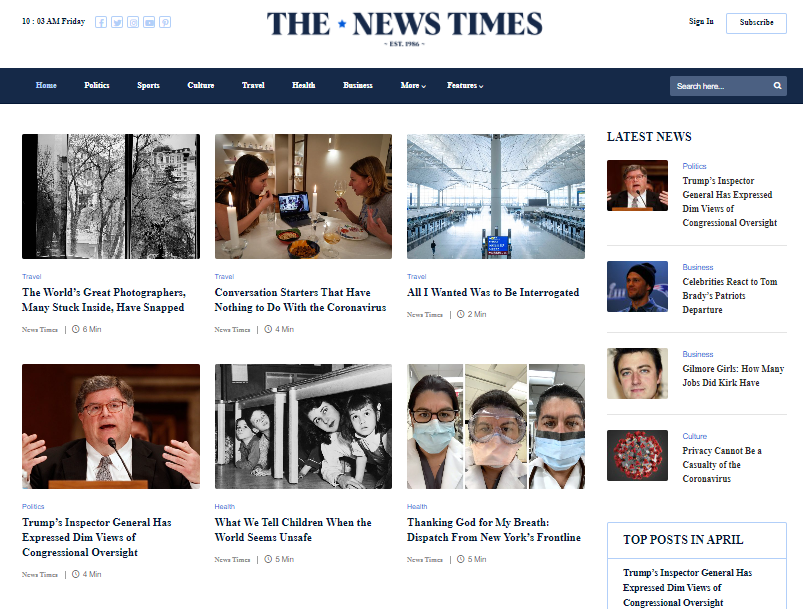The Influence of Social Media Site en route We Consume News Online
Social media has basically changed news usage. It supplies prompt accessibility to details, often overshadowing standard media electrical outlets. This fast dissemination comes with difficulties. Users face the threat of encountering false information and becoming caught in echo chambers. The algorithms driving customized web content can obscure varied viewpoints. As these dynamics progress, comprehending their implications ends up being vital for educated involvement in public discourse. What methods might assist navigate this complex landscape?
The Advancement of News Intake in the Digital Age
As technology progressed, the means people taken in news changed substantially in the digital age (stnews.live). Typical newspapers and relayed media started to decline as the web became a primary resource of information. On the internet systems provided instantaneous access to newspaper article, videos, and podcasts, allowing users to stay notified at any kind of time. The benefit of mobile tools even more increased this shift, making it possible for individuals to receive updates on the go
In addition, the surge of news aggregators and sites promoted the consumption of varied viewpoints, equipping individuals to tailor their news intake based upon individual passions. This evolution likewise triggered wire service to adjust their strategies, concentrating on digital content and appealing visitors via multimedia styles. Because of this, the typical obstacles of time and space in news delivery reduced, leading to a more immediate and personalized news experience for target markets worldwide.
The Duty of Social Network Operatings Systems in News Circulation
Social media platforms have transformed news circulation by providing instantaneous accessibility to information. Their algorithm-driven material curation typically prioritizes interaction over precision, bring about substantial trustworthiness difficulties (stnews.live). As individuals navigate this landscape, the effects for news intake and public discourse come to be significantly intricate
Instantaneous News Accessibility
Although traditional news electrical outlets have actually long been the primary source of information, the increase of social media systems has considerably changed just how news is accessed and eaten. Instantaneous news accessibility has come to be a characteristic of the digital age, allowing customers to get updates in real time. Platforms such as Twitter, Facebook, and Instagram allow news to spread out quickly, commonly exceeding traditional media in rate and reach. Individuals can share tales, talk about events, and involve with reporters, producing a dynamic interaction between the target market and news web content. This immediacy promotes a culture of urgency, prompting individuals to inquire swiftly. Consequently, the expectation for prompt news has actually improved journalistic methods, compelling news companies to adapt their techniques to fulfill the needs of a busy electronic setting.
Algorithm-Driven Content
While users proactively involve with web content on social media sites, the algorithms that regulate these systems play a pivotal function in determining which newspaper article obtain presence. These algorithms examine user actions, preferences, and engagement metrics to curate individualized news feeds. Consequently, certain stories may be magnified while others continue to be unknown, frequently focusing on marvelous or trending subjects over substantive coverage. This selective exposure shapes customers' understandings of present events and affects public discourse. The dependence on algorithm-driven content can produce resemble chambers, where users are primarily exposed to viewpoints that line up with their own beliefs. The dynamics of news distribution on social media systems significantly affect exactly how individuals eat and analyze details in the digital age.
Credibility Challenges
As users significantly turn to social media for news, the reliability of information experienced on these platforms ends up being a pressing issue. The decentralized nature of social media sites allows anybody to release content, usually blurring the lines in between trusted journalism and misinformation. Algorithms prioritize engagement over accuracy, causing the prevalent dissemination of astonishing or misleading tales. This setting presents considerable obstacles for users attempting to determine reliable sources. Social network platforms, while seeking to deal with false information with fact-checking and material moderation, run the gauntlet for variances and predispositions in their methods. Eventually, the duty exists with individuals to critically evaluate the news they consume, as the quick spread of info often outmatches verification efforts by systems.
The Increase of Citizen Journalism and User-Generated Material
The rise of resident journalism has actually equipped daily people to share news and viewpoints, frequently giving insights that conventional media might neglect. However, this change also presents considerable difficulties, especially the spread of false information that can develop from unproven material. As user-generated material becomes a lot more prevalent, the equilibrium between genuine voices and precision in coverage remains an essential worry.
Empowering Day-to-day Voices

Difficulties of False information
While the surge of person journalism has opened opportunities for varied voices in the media landscape, it has also presented considerable difficulties associated with false information. The convenience of sharing information with social media platforms enables people to share news quickly, but this quick spread usually comes with the cost of precision. User-generated material frequently lacks the strenuous fact-checking and editorial oversight that standard journalism supplies. As a result, sensationalized or false stories can obtain grip, misinforming target markets and shaping public assumption (stnews.live). Moreover, the mixing of opinion and reality within social networks complicates the distinction between qualified info and false information. Because of this, customers need to navigate a significantly intricate media environment, calling for essential assuming skills to discern reliable news resources in the middle of the sound

False information and Its Ramifications for Public Discussion
As social media sites systems increasingly control the landscape of info dissemination, the spreading of misinformation presents significant obstacles for public discourse. Misinformation, often made to misinform or prompt emotional feedbacks, can distort assumptions of truth and threaten rely on reliable resources. This sensation causes polarized perspectives, as people gravitate towards resemble chambers that enhance their beliefs, additionally setting divisions within society.
The effects for public discussion are profound. When residents count on incorrect details, meaningful dialogue reduces, and the autonomous procedure suffers. Moreover, false information can provoke fear and complication, affecting public health and wellness, security, and political security. As an outcome, promoting media literacy becomes important, equipping individuals to critically evaluate details and recognize reality from fiction. Resolving the challenges positioned by misinformation is important for protecting the stability of public discourse and ensuring a knowledgeable people with the ability of taking part in useful conversations.
The Influence of Formulas on News Presence
Offered the main duty of algorithms in figuring out material presence, their impact on news consumption is extensive. These formulas, made use of by social media sites platforms, prioritize certain sorts of content based upon user engagement and preferences. Consequently, news short articles that line up with preferred patterns or audience passions are more probable to be displayed plainly, while much less marvelous tales might be overlooked. This creates a setting where individuals are subjected largely to details that strengthens their point of views, possibly causing resemble chambers.
The continuous evolution of algorithms means that news companies must adapt their techniques to align with these altering specifications, typically prioritizing clickbait or psychologically billed headings. The integrity of news reporting can be compromised, as critical tales might not obtain the visibility they are entitled to. The mathematical shaping of news presence consequently plays a necessary duty in affecting public perception and understanding of current events.
The Change Towards Aesthetic Storytelling in News Media
Increasingly, news media is welcoming visual storytelling as an effective tool to engage target markets. This approach leverages images, video clips, infographics, and interactive aspects to communicate details extra effectively than standard text-based layouts. As attention spans reduce, visuals provide a quick, impactful way to communicate complicated tales and order visitors' rate of interest.
Systems like Instagram and TikTok have additional increased this pattern, compelling news organizations to adapt their web content techniques to fit these visually-driven atmospheres. By incorporating engaging visuals, news electrical outlets can enhance emotional connections and foster greater understanding of topical concerns.
Aesthetic storytelling permits for more varied stories, showcasing multiple viewpoints through vibrant discussions. As audiences significantly consume news with smart More hints phones, the change toward visuals not only satisfies customer preferences however also helps to break down barriers to details gain access to. Inevitably, this evolution mirrors a more comprehensive change in just how news is produced and eaten in the electronic age.
Future Fads: Navigating the Transforming Landscape of News Consumption
While the electronic landscape remains to evolve, news intake is positioned for substantial makeover driven by emerging innovations and altering target market behaviors. As expert system and artificial intelligence breakthrough, customized news feeds will become much more widespread, enabling individuals to obtain content customized to their interests. This customization can result in greater interaction yet likewise increase worries concerning echo chambers and misinformation.
In addition, the surge of voice-activated gadgets and smart speakers will certainly affect just how news is delivered, moving the focus from visual to auditory styles. This trend may urge wire service to embrace more succinct and interesting audio web content.

Often Asked Inquiries
How Do Social Network Interactions Affect News Integrity?
Social network interactions can substantially influence he said perceptions of news trustworthiness. Involvement metrics, such as likes and shares, typically shape audience count on, with preferred articles gaining regarded legitimacy, no matter of the accuracy or integrity of the info provided.
What Function Do Influencers Play in Shaping News Narratives?
Influencers significantly shape news narratives by leveraging their systems to magnify certain tales, often tailoring content to their target market. This can lead to prejudiced perspectives, affecting public perception and prioritizing sensationalism over accurate coverage.
Exactly How Can Users Identify Reliable News Resources on Social Media?
Customers can identify trusted news sources on social media sites by inspecting the resource's integrity, verifying truths via multiple electrical outlets, reviewing the expertise of the content, and recognizing possible predispositions in reporting to guarantee accurate details.
What Influence Does Social Media Have on Typical Journalism Jobs?
Social media substantially affects traditional journalism tasks by changing revenue designs, decreasing demand for print media, and cultivating competition from person journalists. As a result, lots of specialists encounter job insecurity and should adapt to swiftly transforming media landscapes.
How Do Different Demographics Consume News on Social Media?
Different demographics exhibit varied preferences for news consumption on social media. Younger audiences favor platforms like TikTok and Instagram for fast updates, while older people often tend to favor Twitter and facebook for extra in-depth discussions and articles.